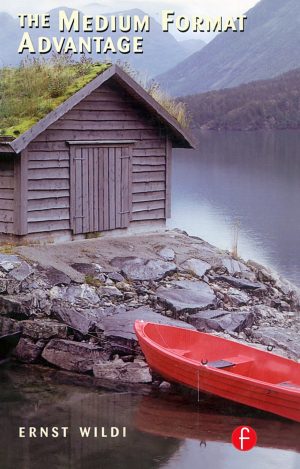The Medium Format Advantage
by Ernst Wildi

Learn the advantages and capabilities of medium-format cameras and examine all aspects of medium-format operations, including SLR, twin lens, panoramic, rangefinder, wide angle, press, and view cameras. Also explained and illustrated are lenses and their accessories, motor drives, films, flashes, filters, slides and slide projectors, and more. Includes black and white and color photographs and drawings to illustrate proper use of equipment and various techniques, effects, and possibilities that produce successful photographs with the best possible image quality.
The medium format is truly the format in the middle. It combines many of the benefits of 35 mm photography with those of the large format, making a medium format system an excellent choice for almost all types of photography from candid action with a hand-held camera to critical studio work from a tripod. Special chapters are devoted to these different applications and the type of equipment that most likely meets your photography needs. This book explains clearly the medium format's benefits, advantages, and disadvantages and provides a comparison of the medium format to other formats so you can decide whether it is right for you and your photography.
Contents
Chapter 1 – The History of Medium Format
Chapter 2 – The Medium Format Advantages
- Image Sharpness
- Image Evaluation
- Focusing Screen
- Cropping
- Film Changing
- Instant Photography and Electronic Imaging
- Shutters
- Camera Size and Operation
Chapter 3 – Image Formats
- Selecting the Format
- Comparing Formats
- Image Sharpness
- Other Medium Formats
- 35mm film in the Medium Format Camera
Chapter 4 – Films and Film Loading
- General Comments
- Color Negative and Color Transparency Film
- Roll Film
- Sheet Film
- Instant Film
- Film Loading
- Operating Signals
Chapter 5 – Camera Types
- Single Lens Reflex Cameras
- Twin Lens Reflex Cameras
- Rangefinder Cameras
- Wide Angle Cameras
- Panoramic Cameras
- Press Cameras
- Cameras with Swing and Tilt Control
- Studio Cameras
- Motor Drives
Chapter 6 – Shutters
- Focal Plane Shutters
- Lens Shutters
- Operating the Cameras
Chapter 7 – Image Quality
- Handheld or Tripod
- Handheld Photography
- Camera Use and Operation on a Tripod
- Selecting a Tripod
- Monopods
Chapter 8 – Lens Design and Performance
- Lens Cost
- Focal Length
- Angle of View
- Area Coverage
- Covering Power
- Lens Aperture
- Lens Names and Engravings
- Telephoto Lens Design
- Wide Angle Lens Designs
- Characteristics and Use of Teleconverters
- Zoom Lenses
- Makro Lenses
- Soft Focus Lenses
- Lens Quality
- Lens Flare and Multicoating
- Relative Illuminance
- Color Rendition
- Image Distortions
Chapter 9 – Lens Controls for Creating Images
- Area Coverage
- Perspective
- Selective Backgrounds
- Slanted Verticals
- Creating Images with Zoom Lenses
- Fish-Eye Lens Photography
- Depth of Field
- Increasing the Sharpness Range
- Creative Use of Lens Aperture
- Action and Shutter Speed
Chapter 10 – Creating the Image in the Viewfinder
- Optical Viewfinders
- Rangefinder Focusing
- Automatic Focusing
- Focusing Screens
- Viewfinders
- Image Evaluation
- Leveling the Camera
- Image Composition
Chapter 11 – Exposure and Metering Modes
- Lens Aperture
- Shutter Speed
- Exposure Values
- Film Sensitivity
- Determining Lens Settings
- Metering Methods
- Meters as Part of the Camera System
- Using the Reflected Meter
- Shaded and Lighted Areas
- Bracketing
- Special Exposure Situations
- Other Uses of Meters and Gray Cards
Chapter 12 – Medium Format Flash Photography
- Flash Synchronization
- Flash Unit Size and Batteries
- Light Output and Guide Numbers
- Covering Power
- Ready Light and Exposure Signal
- Use and Placement of the Flash Unit
- Operating the Portable Flash Unit
- Making the Existing Light Part of the Picture
- Other Exposure Considerations
- Other Flash Applications
Chapter 13 – Close-Up Photography
- Camera Designs
- Lenses for Close-Up Photography
- Close-Up Accessories
- Magnification
- Close-Up Lenses
- Extension Tubes and Bellows
- Photographing Subjects Life Sized
- Depth of Field
- Exposure
Chapter 14 – Filters for Better Image Quality
- Exposure Increase
- Filters as Lens Protection
- Haze and Ultraviolet Filters
- Neutral Density Filters
- Filters for Black-and-White Photography
- Color Quality of Light
- Filters for Color Photography
- Polarizing Filters
- Partial Filters
- Quality of Filters
- Filter Maintenance
Chapter 15 – Digital Imaging in the Medium Format
- The New Possibilities
- Selecting Digital Equipment
- Selecting Lenses for Electronic Imaging
Chapter 16 – Applications and Specialized Fields of Photography
- Wildlife and Bird Photography
- Nature Photography
- Outdoor Scenery
- High Magnification Photography
- Photography Through the Microscope
- Aerial Photography
- Architectural Photography
- Wedding Photography
- Fashion and Beauty Photography
- Portrait Photography
- Child Photography
- Soft Focus Photography
- Press Photography
- Sports Photography
- Medical Photography
- Commercial Photography
- Industrial Photography
- Creative Experimenting
- Slide Duplicating
- Copying
- Underwater Photography
- Infrared Photography
- Ultraviolet Photography
- Fluorescence Photography
Chapter 17 – Slides and Slide Projection
- Projection Formats
- Slides and Slide Mounting
- Slide Projectors
- Slide Presentations
Chapter 18 – Maintaining Equipment and Materials
- Carrying Cases
- Cleaning the Camera
- Environmental Factors
- X-Ray Inspections
Ernst Wildi is an independent writer and consultant to Hasselblad who has lectured all over the world on medium format photography. He has written several hundred articles on photography and filmmaking. His photographic work has won many international awards, and he is the recipient of the 1999 International Award from the American Society of Photographers.
